Developing an Audit Program for Legend Corporation Limited: Report
VerifiedAdded on 2022/11/10
|21
|4777
|213
Report
AI Summary
This report provides a comprehensive audit analysis of Legend Corporation Limited, an Australian engineering services company. It begins with an executive summary and an introduction to the importance of auditing, followed by an identification of key business risks such as interest rate risk, foreign currency risk, liquidity risk, and credit risk. The report then delves into material misstatements, audit risk models, and analytical procedures, including ratio analysis to assess financial performance and position. It discusses the concept of materiality, identifies material accounts, and outlines corresponding assertions and audit procedures. The report emphasizes the use of sampling methods for testing material accounts and concludes with a summary of findings and recommendations. References are provided to support the analysis.
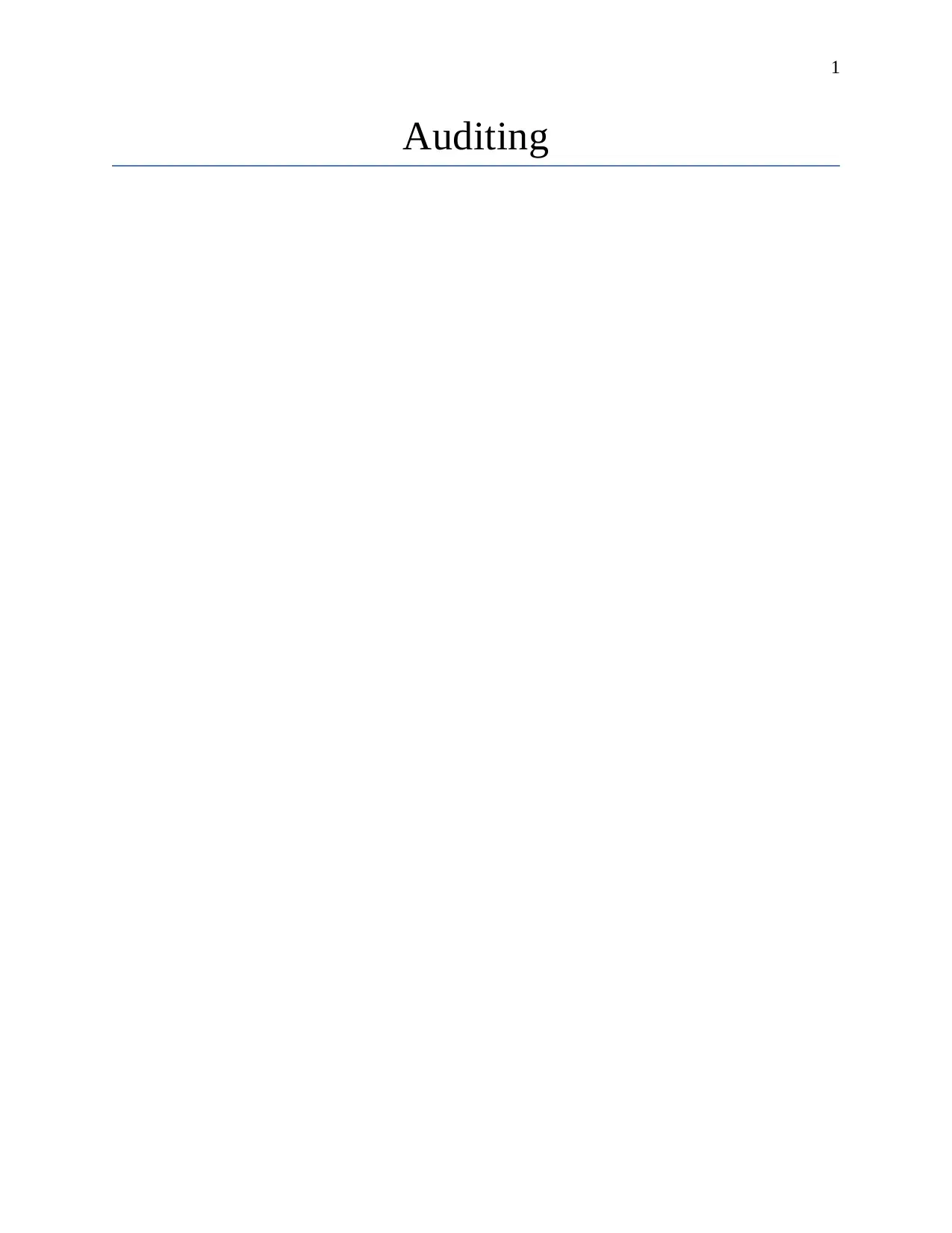
1
Auditing
Auditing
Paraphrase This Document
Need a fresh take? Get an instant paraphrase of this document with our AI Paraphraser
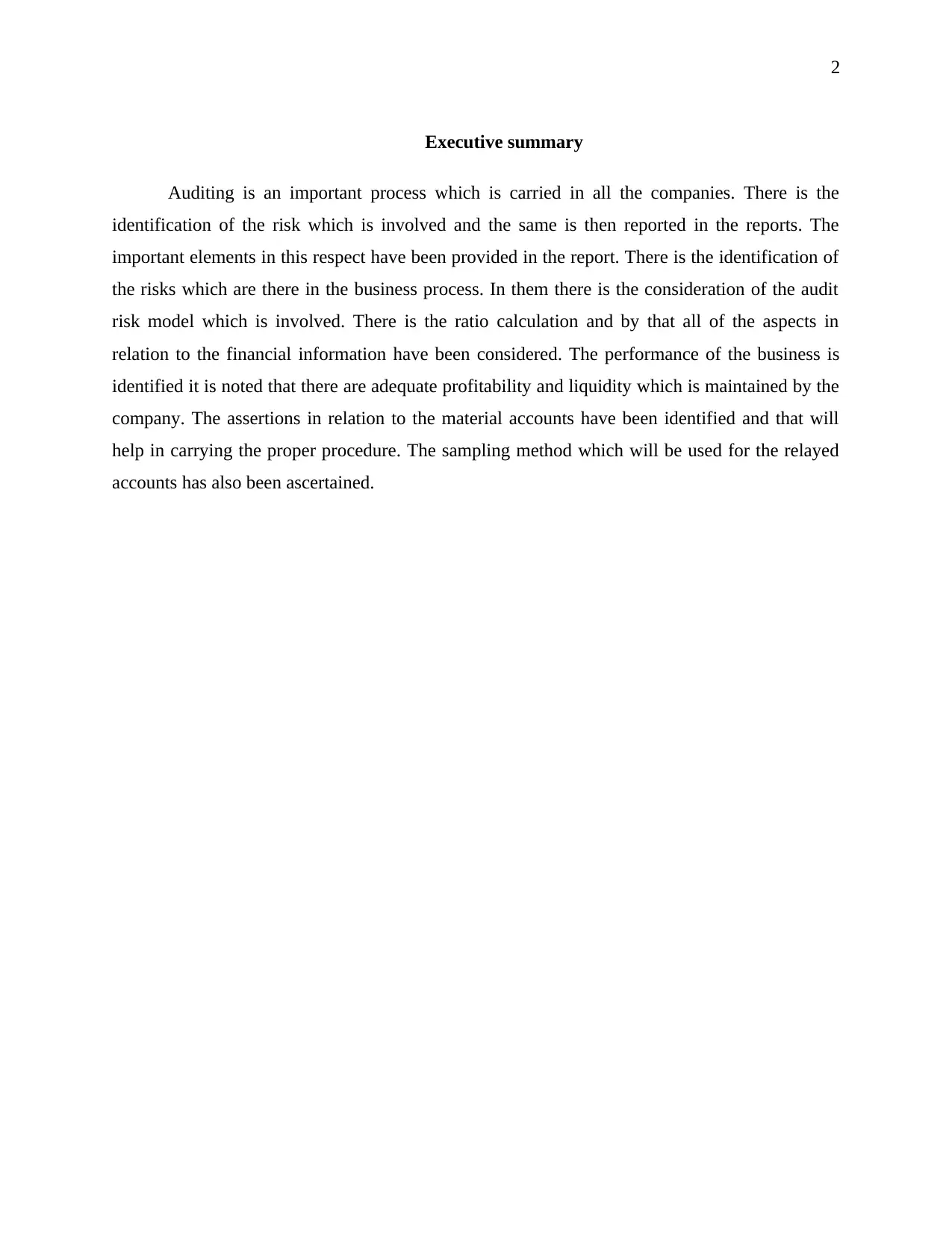
2
Executive summary
Auditing is an important process which is carried in all the companies. There is the
identification of the risk which is involved and the same is then reported in the reports. The
important elements in this respect have been provided in the report. There is the identification of
the risks which are there in the business process. In them there is the consideration of the audit
risk model which is involved. There is the ratio calculation and by that all of the aspects in
relation to the financial information have been considered. The performance of the business is
identified it is noted that there are adequate profitability and liquidity which is maintained by the
company. The assertions in relation to the material accounts have been identified and that will
help in carrying the proper procedure. The sampling method which will be used for the relayed
accounts has also been ascertained.
Executive summary
Auditing is an important process which is carried in all the companies. There is the
identification of the risk which is involved and the same is then reported in the reports. The
important elements in this respect have been provided in the report. There is the identification of
the risks which are there in the business process. In them there is the consideration of the audit
risk model which is involved. There is the ratio calculation and by that all of the aspects in
relation to the financial information have been considered. The performance of the business is
identified it is noted that there are adequate profitability and liquidity which is maintained by the
company. The assertions in relation to the material accounts have been identified and that will
help in carrying the proper procedure. The sampling method which will be used for the relayed
accounts has also been ascertained.
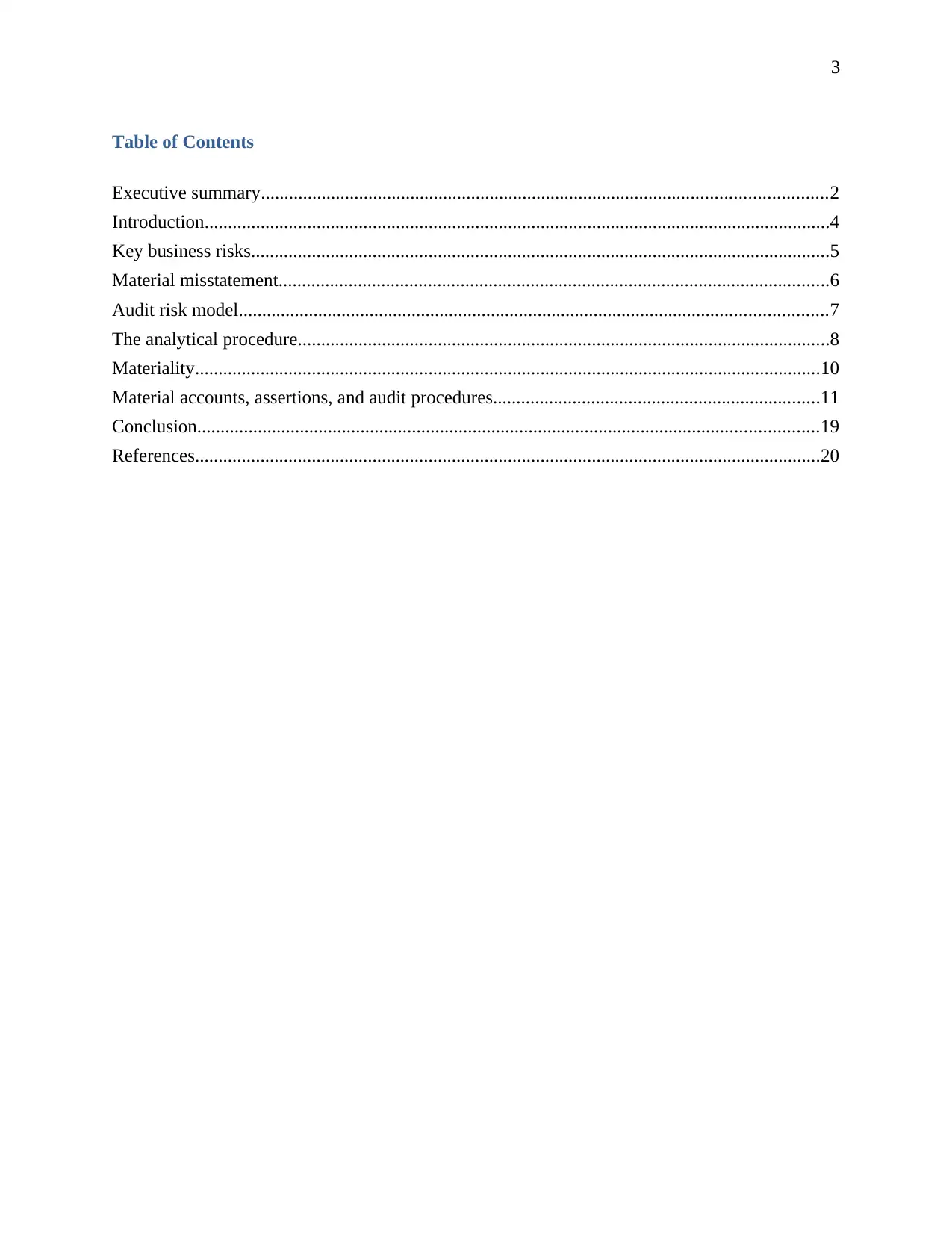
3
Table of Contents
Executive summary.........................................................................................................................2
Introduction......................................................................................................................................4
Key business risks............................................................................................................................5
Material misstatement......................................................................................................................6
Audit risk model..............................................................................................................................7
The analytical procedure..................................................................................................................8
Materiality......................................................................................................................................10
Material accounts, assertions, and audit procedures......................................................................11
Conclusion.....................................................................................................................................19
References......................................................................................................................................20
Table of Contents
Executive summary.........................................................................................................................2
Introduction......................................................................................................................................4
Key business risks............................................................................................................................5
Material misstatement......................................................................................................................6
Audit risk model..............................................................................................................................7
The analytical procedure..................................................................................................................8
Materiality......................................................................................................................................10
Material accounts, assertions, and audit procedures......................................................................11
Conclusion.....................................................................................................................................19
References......................................................................................................................................20
⊘ This is a preview!⊘
Do you want full access?
Subscribe today to unlock all pages.

Trusted by 1+ million students worldwide
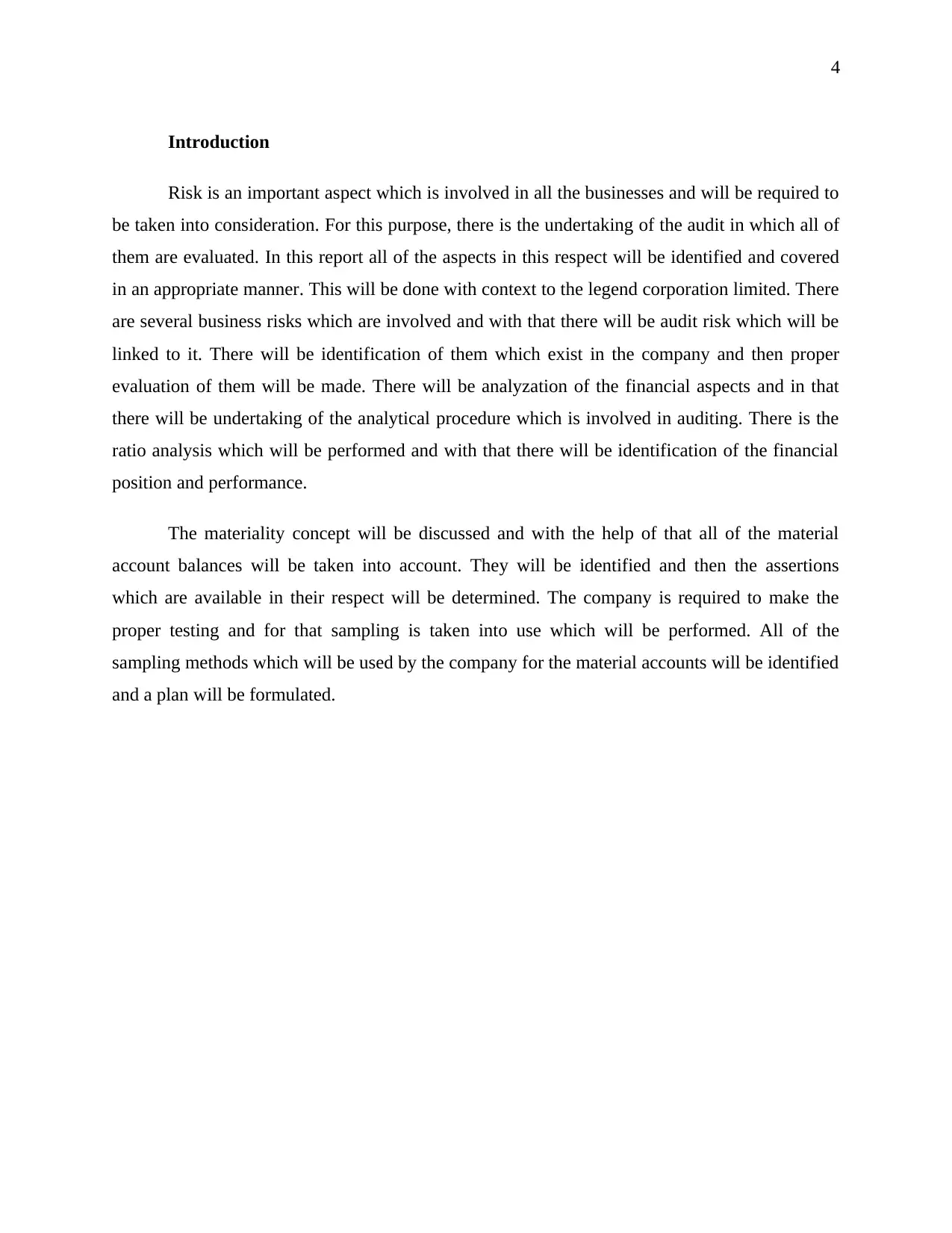
4
Introduction
Risk is an important aspect which is involved in all the businesses and will be required to
be taken into consideration. For this purpose, there is the undertaking of the audit in which all of
them are evaluated. In this report all of the aspects in this respect will be identified and covered
in an appropriate manner. This will be done with context to the legend corporation limited. There
are several business risks which are involved and with that there will be audit risk which will be
linked to it. There will be identification of them which exist in the company and then proper
evaluation of them will be made. There will be analyzation of the financial aspects and in that
there will be undertaking of the analytical procedure which is involved in auditing. There is the
ratio analysis which will be performed and with that there will be identification of the financial
position and performance.
The materiality concept will be discussed and with the help of that all of the material
account balances will be taken into account. They will be identified and then the assertions
which are available in their respect will be determined. The company is required to make the
proper testing and for that sampling is taken into use which will be performed. All of the
sampling methods which will be used by the company for the material accounts will be identified
and a plan will be formulated.
Introduction
Risk is an important aspect which is involved in all the businesses and will be required to
be taken into consideration. For this purpose, there is the undertaking of the audit in which all of
them are evaluated. In this report all of the aspects in this respect will be identified and covered
in an appropriate manner. This will be done with context to the legend corporation limited. There
are several business risks which are involved and with that there will be audit risk which will be
linked to it. There will be identification of them which exist in the company and then proper
evaluation of them will be made. There will be analyzation of the financial aspects and in that
there will be undertaking of the analytical procedure which is involved in auditing. There is the
ratio analysis which will be performed and with that there will be identification of the financial
position and performance.
The materiality concept will be discussed and with the help of that all of the material
account balances will be taken into account. They will be identified and then the assertions
which are available in their respect will be determined. The company is required to make the
proper testing and for that sampling is taken into use which will be performed. All of the
sampling methods which will be used by the company for the material accounts will be identified
and a plan will be formulated.
Paraphrase This Document
Need a fresh take? Get an instant paraphrase of this document with our AI Paraphraser
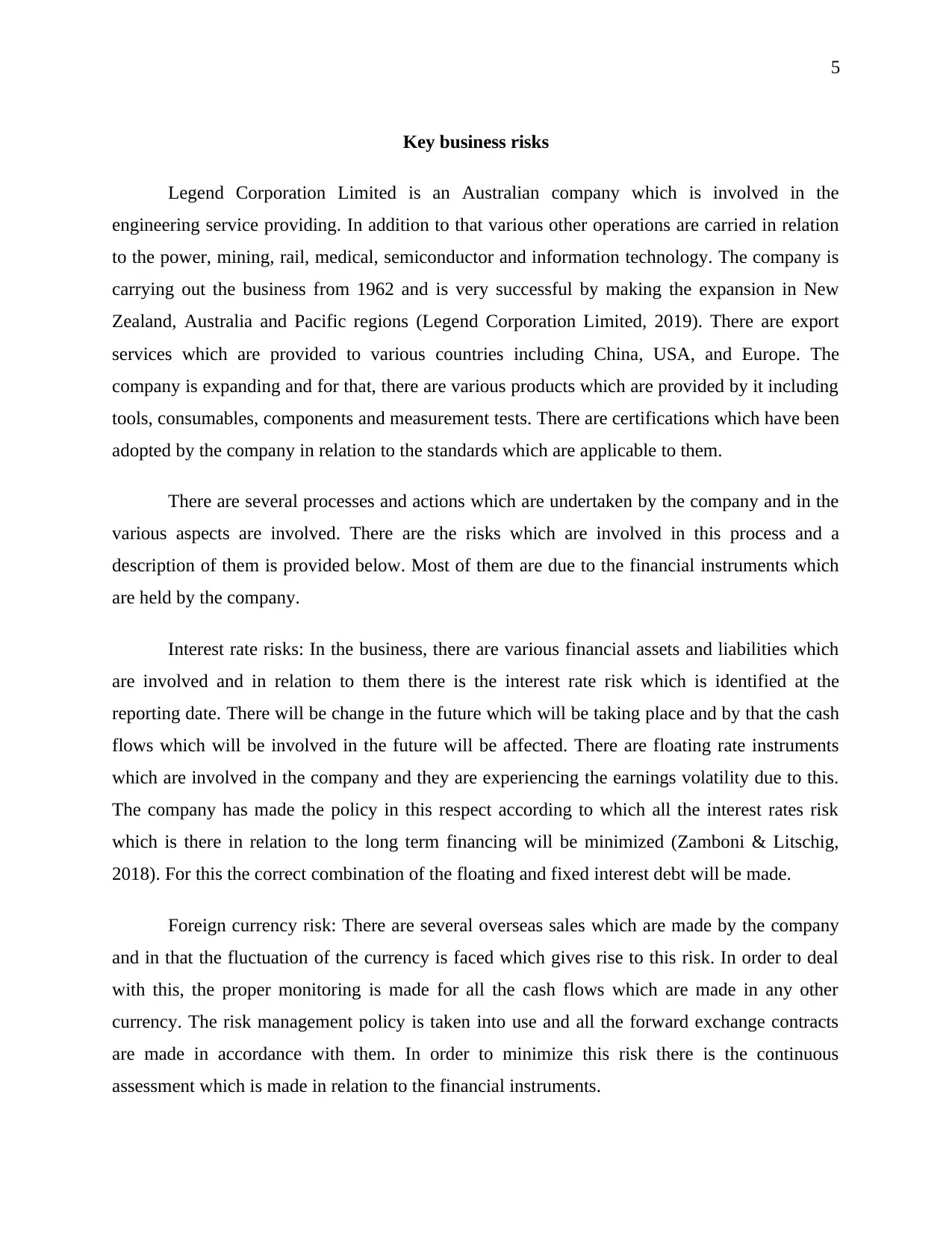
5
Key business risks
Legend Corporation Limited is an Australian company which is involved in the
engineering service providing. In addition to that various other operations are carried in relation
to the power, mining, rail, medical, semiconductor and information technology. The company is
carrying out the business from 1962 and is very successful by making the expansion in New
Zealand, Australia and Pacific regions (Legend Corporation Limited, 2019). There are export
services which are provided to various countries including China, USA, and Europe. The
company is expanding and for that, there are various products which are provided by it including
tools, consumables, components and measurement tests. There are certifications which have been
adopted by the company in relation to the standards which are applicable to them.
There are several processes and actions which are undertaken by the company and in the
various aspects are involved. There are the risks which are involved in this process and a
description of them is provided below. Most of them are due to the financial instruments which
are held by the company.
Interest rate risks: In the business, there are various financial assets and liabilities which
are involved and in relation to them there is the interest rate risk which is identified at the
reporting date. There will be change in the future which will be taking place and by that the cash
flows which will be involved in the future will be affected. There are floating rate instruments
which are involved in the company and they are experiencing the earnings volatility due to this.
The company has made the policy in this respect according to which all the interest rates risk
which is there in relation to the long term financing will be minimized (Zamboni & Litschig,
2018). For this the correct combination of the floating and fixed interest debt will be made.
Foreign currency risk: There are several overseas sales which are made by the company
and in that the fluctuation of the currency is faced which gives rise to this risk. In order to deal
with this, the proper monitoring is made for all the cash flows which are made in any other
currency. The risk management policy is taken into use and all the forward exchange contracts
are made in accordance with them. In order to minimize this risk there is the continuous
assessment which is made in relation to the financial instruments.
Key business risks
Legend Corporation Limited is an Australian company which is involved in the
engineering service providing. In addition to that various other operations are carried in relation
to the power, mining, rail, medical, semiconductor and information technology. The company is
carrying out the business from 1962 and is very successful by making the expansion in New
Zealand, Australia and Pacific regions (Legend Corporation Limited, 2019). There are export
services which are provided to various countries including China, USA, and Europe. The
company is expanding and for that, there are various products which are provided by it including
tools, consumables, components and measurement tests. There are certifications which have been
adopted by the company in relation to the standards which are applicable to them.
There are several processes and actions which are undertaken by the company and in the
various aspects are involved. There are the risks which are involved in this process and a
description of them is provided below. Most of them are due to the financial instruments which
are held by the company.
Interest rate risks: In the business, there are various financial assets and liabilities which
are involved and in relation to them there is the interest rate risk which is identified at the
reporting date. There will be change in the future which will be taking place and by that the cash
flows which will be involved in the future will be affected. There are floating rate instruments
which are involved in the company and they are experiencing the earnings volatility due to this.
The company has made the policy in this respect according to which all the interest rates risk
which is there in relation to the long term financing will be minimized (Zamboni & Litschig,
2018). For this the correct combination of the floating and fixed interest debt will be made.
Foreign currency risk: There are several overseas sales which are made by the company
and in that the fluctuation of the currency is faced which gives rise to this risk. In order to deal
with this, the proper monitoring is made for all the cash flows which are made in any other
currency. The risk management policy is taken into use and all the forward exchange contracts
are made in accordance with them. In order to minimize this risk there is the continuous
assessment which is made in relation to the financial instruments.
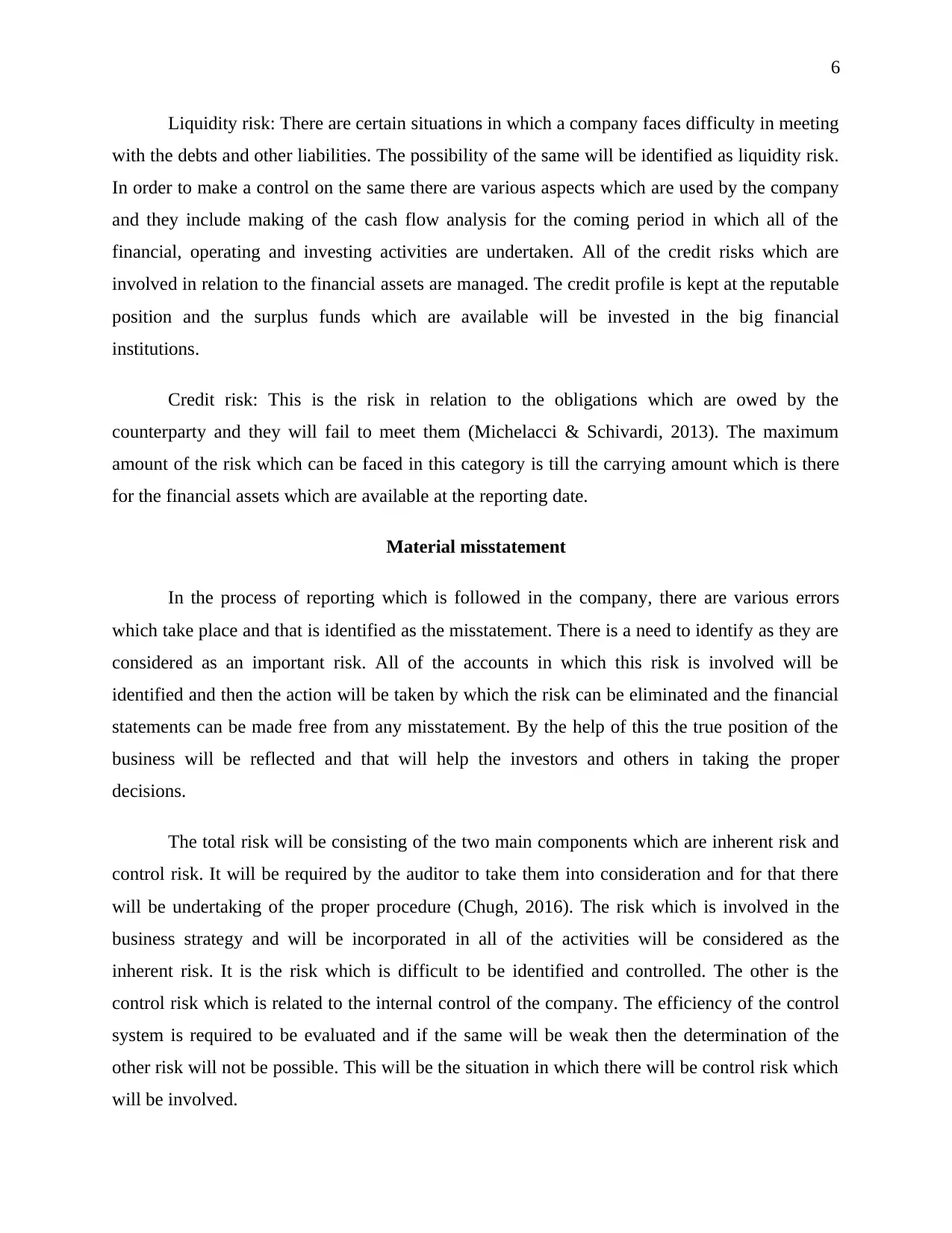
6
Liquidity risk: There are certain situations in which a company faces difficulty in meeting
with the debts and other liabilities. The possibility of the same will be identified as liquidity risk.
In order to make a control on the same there are various aspects which are used by the company
and they include making of the cash flow analysis for the coming period in which all of the
financial, operating and investing activities are undertaken. All of the credit risks which are
involved in relation to the financial assets are managed. The credit profile is kept at the reputable
position and the surplus funds which are available will be invested in the big financial
institutions.
Credit risk: This is the risk in relation to the obligations which are owed by the
counterparty and they will fail to meet them (Michelacci & Schivardi, 2013). The maximum
amount of the risk which can be faced in this category is till the carrying amount which is there
for the financial assets which are available at the reporting date.
Material misstatement
In the process of reporting which is followed in the company, there are various errors
which take place and that is identified as the misstatement. There is a need to identify as they are
considered as an important risk. All of the accounts in which this risk is involved will be
identified and then the action will be taken by which the risk can be eliminated and the financial
statements can be made free from any misstatement. By the help of this the true position of the
business will be reflected and that will help the investors and others in taking the proper
decisions.
The total risk will be consisting of the two main components which are inherent risk and
control risk. It will be required by the auditor to take them into consideration and for that there
will be undertaking of the proper procedure (Chugh, 2016). The risk which is involved in the
business strategy and will be incorporated in all of the activities will be considered as the
inherent risk. It is the risk which is difficult to be identified and controlled. The other is the
control risk which is related to the internal control of the company. The efficiency of the control
system is required to be evaluated and if the same will be weak then the determination of the
other risk will not be possible. This will be the situation in which there will be control risk which
will be involved.
Liquidity risk: There are certain situations in which a company faces difficulty in meeting
with the debts and other liabilities. The possibility of the same will be identified as liquidity risk.
In order to make a control on the same there are various aspects which are used by the company
and they include making of the cash flow analysis for the coming period in which all of the
financial, operating and investing activities are undertaken. All of the credit risks which are
involved in relation to the financial assets are managed. The credit profile is kept at the reputable
position and the surplus funds which are available will be invested in the big financial
institutions.
Credit risk: This is the risk in relation to the obligations which are owed by the
counterparty and they will fail to meet them (Michelacci & Schivardi, 2013). The maximum
amount of the risk which can be faced in this category is till the carrying amount which is there
for the financial assets which are available at the reporting date.
Material misstatement
In the process of reporting which is followed in the company, there are various errors
which take place and that is identified as the misstatement. There is a need to identify as they are
considered as an important risk. All of the accounts in which this risk is involved will be
identified and then the action will be taken by which the risk can be eliminated and the financial
statements can be made free from any misstatement. By the help of this the true position of the
business will be reflected and that will help the investors and others in taking the proper
decisions.
The total risk will be consisting of the two main components which are inherent risk and
control risk. It will be required by the auditor to take them into consideration and for that there
will be undertaking of the proper procedure (Chugh, 2016). The risk which is involved in the
business strategy and will be incorporated in all of the activities will be considered as the
inherent risk. It is the risk which is difficult to be identified and controlled. The other is the
control risk which is related to the internal control of the company. The efficiency of the control
system is required to be evaluated and if the same will be weak then the determination of the
other risk will not be possible. This will be the situation in which there will be control risk which
will be involved.
⊘ This is a preview!⊘
Do you want full access?
Subscribe today to unlock all pages.

Trusted by 1+ million students worldwide
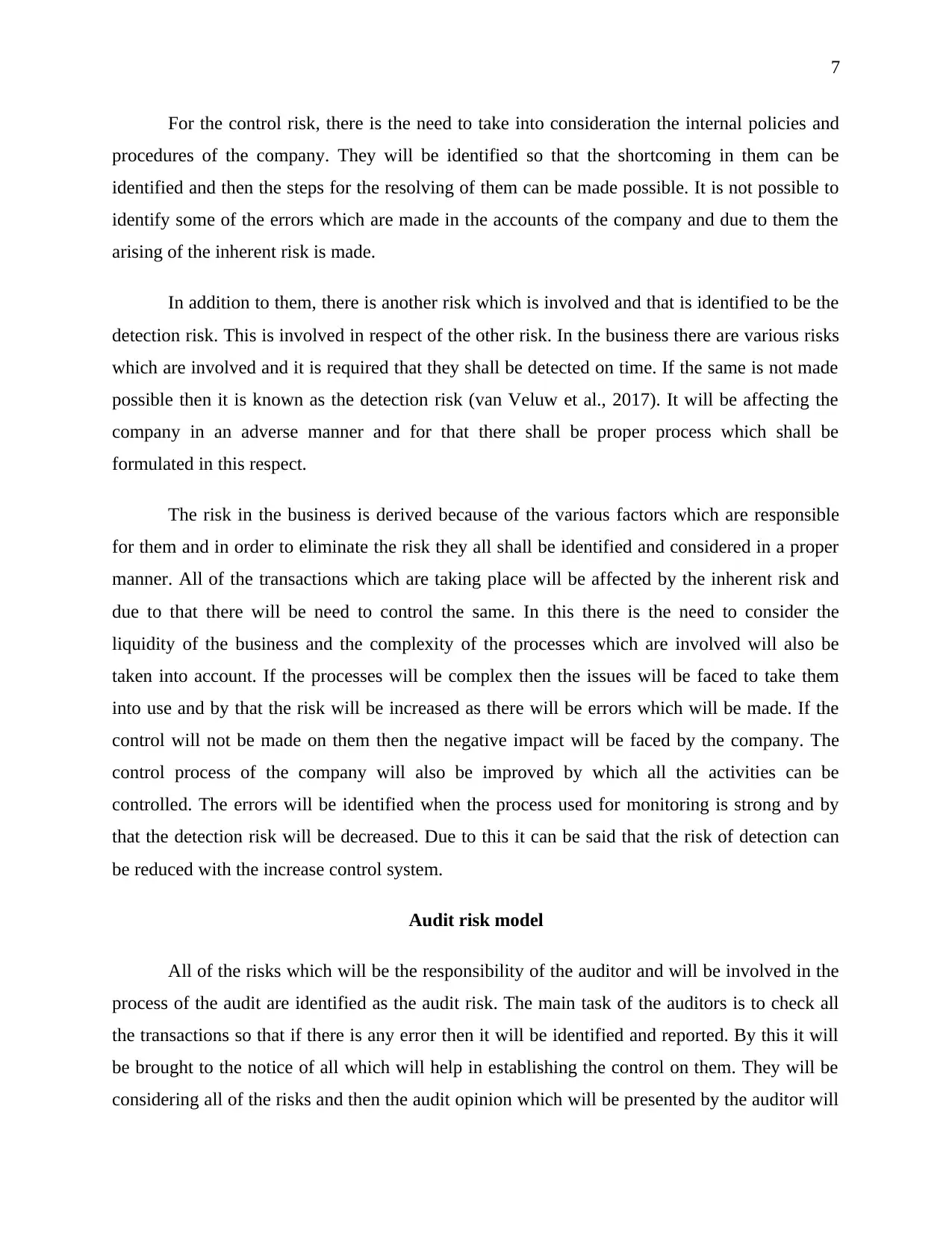
7
For the control risk, there is the need to take into consideration the internal policies and
procedures of the company. They will be identified so that the shortcoming in them can be
identified and then the steps for the resolving of them can be made possible. It is not possible to
identify some of the errors which are made in the accounts of the company and due to them the
arising of the inherent risk is made.
In addition to them, there is another risk which is involved and that is identified to be the
detection risk. This is involved in respect of the other risk. In the business there are various risks
which are involved and it is required that they shall be detected on time. If the same is not made
possible then it is known as the detection risk (van Veluw et al., 2017). It will be affecting the
company in an adverse manner and for that there shall be proper process which shall be
formulated in this respect.
The risk in the business is derived because of the various factors which are responsible
for them and in order to eliminate the risk they all shall be identified and considered in a proper
manner. All of the transactions which are taking place will be affected by the inherent risk and
due to that there will be need to control the same. In this there is the need to consider the
liquidity of the business and the complexity of the processes which are involved will also be
taken into account. If the processes will be complex then the issues will be faced to take them
into use and by that the risk will be increased as there will be errors which will be made. If the
control will not be made on them then the negative impact will be faced by the company. The
control process of the company will also be improved by which all the activities can be
controlled. The errors will be identified when the process used for monitoring is strong and by
that the detection risk will be decreased. Due to this it can be said that the risk of detection can
be reduced with the increase control system.
Audit risk model
All of the risks which will be the responsibility of the auditor and will be involved in the
process of the audit are identified as the audit risk. The main task of the auditors is to check all
the transactions so that if there is any error then it will be identified and reported. By this it will
be brought to the notice of all which will help in establishing the control on them. They will be
considering all of the risks and then the audit opinion which will be presented by the auditor will
For the control risk, there is the need to take into consideration the internal policies and
procedures of the company. They will be identified so that the shortcoming in them can be
identified and then the steps for the resolving of them can be made possible. It is not possible to
identify some of the errors which are made in the accounts of the company and due to them the
arising of the inherent risk is made.
In addition to them, there is another risk which is involved and that is identified to be the
detection risk. This is involved in respect of the other risk. In the business there are various risks
which are involved and it is required that they shall be detected on time. If the same is not made
possible then it is known as the detection risk (van Veluw et al., 2017). It will be affecting the
company in an adverse manner and for that there shall be proper process which shall be
formulated in this respect.
The risk in the business is derived because of the various factors which are responsible
for them and in order to eliminate the risk they all shall be identified and considered in a proper
manner. All of the transactions which are taking place will be affected by the inherent risk and
due to that there will be need to control the same. In this there is the need to consider the
liquidity of the business and the complexity of the processes which are involved will also be
taken into account. If the processes will be complex then the issues will be faced to take them
into use and by that the risk will be increased as there will be errors which will be made. If the
control will not be made on them then the negative impact will be faced by the company. The
control process of the company will also be improved by which all the activities can be
controlled. The errors will be identified when the process used for monitoring is strong and by
that the detection risk will be decreased. Due to this it can be said that the risk of detection can
be reduced with the increase control system.
Audit risk model
All of the risks which will be the responsibility of the auditor and will be involved in the
process of the audit are identified as the audit risk. The main task of the auditors is to check all
the transactions so that if there is any error then it will be identified and reported. By this it will
be brought to the notice of all which will help in establishing the control on them. They will be
considering all of the risks and then the audit opinion which will be presented by the auditor will
Paraphrase This Document
Need a fresh take? Get an instant paraphrase of this document with our AI Paraphraser
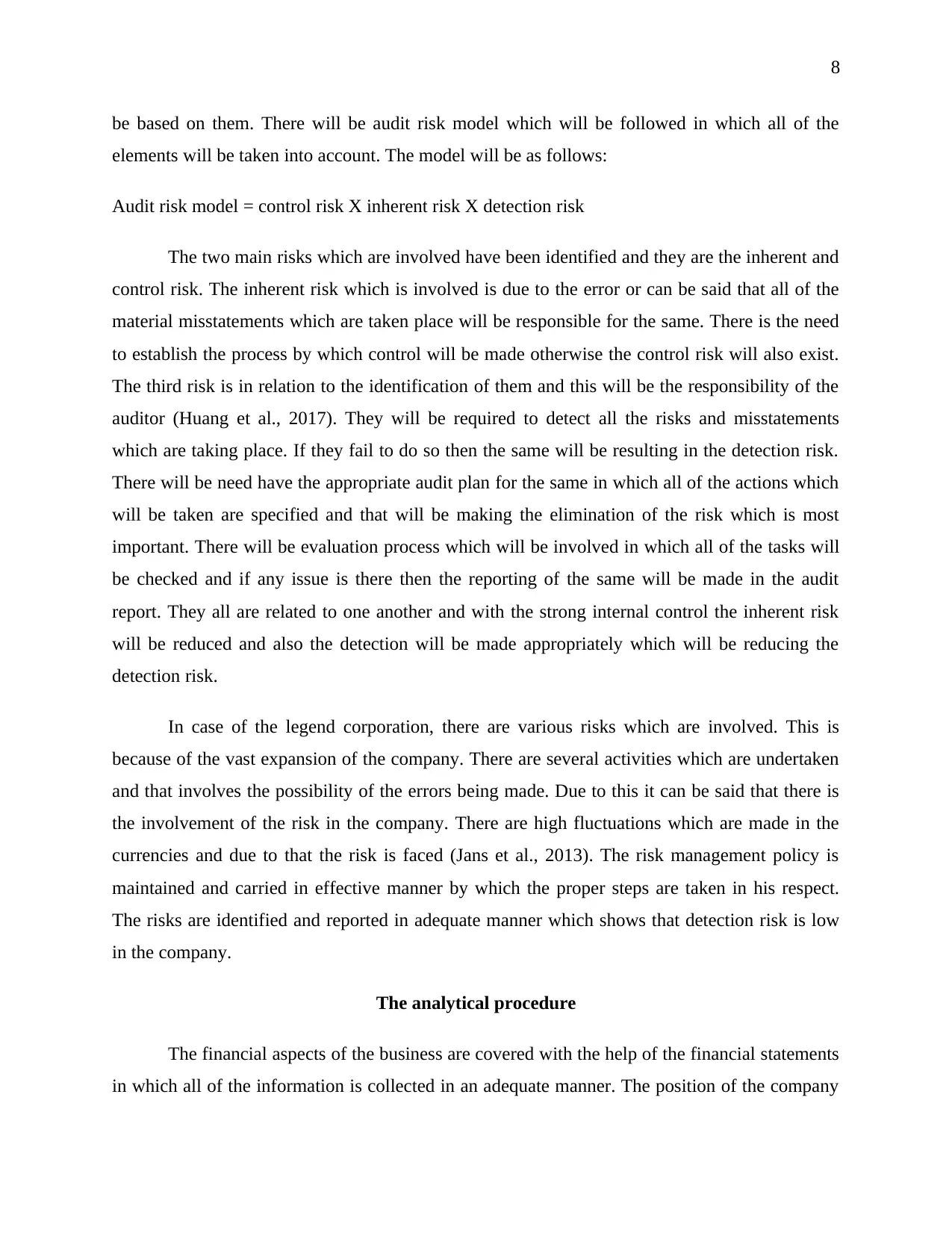
8
be based on them. There will be audit risk model which will be followed in which all of the
elements will be taken into account. The model will be as follows:
Audit risk model = control risk X inherent risk X detection risk
The two main risks which are involved have been identified and they are the inherent and
control risk. The inherent risk which is involved is due to the error or can be said that all of the
material misstatements which are taken place will be responsible for the same. There is the need
to establish the process by which control will be made otherwise the control risk will also exist.
The third risk is in relation to the identification of them and this will be the responsibility of the
auditor (Huang et al., 2017). They will be required to detect all the risks and misstatements
which are taking place. If they fail to do so then the same will be resulting in the detection risk.
There will be need have the appropriate audit plan for the same in which all of the actions which
will be taken are specified and that will be making the elimination of the risk which is most
important. There will be evaluation process which will be involved in which all of the tasks will
be checked and if any issue is there then the reporting of the same will be made in the audit
report. They all are related to one another and with the strong internal control the inherent risk
will be reduced and also the detection will be made appropriately which will be reducing the
detection risk.
In case of the legend corporation, there are various risks which are involved. This is
because of the vast expansion of the company. There are several activities which are undertaken
and that involves the possibility of the errors being made. Due to this it can be said that there is
the involvement of the risk in the company. There are high fluctuations which are made in the
currencies and due to that the risk is faced (Jans et al., 2013). The risk management policy is
maintained and carried in effective manner by which the proper steps are taken in his respect.
The risks are identified and reported in adequate manner which shows that detection risk is low
in the company.
The analytical procedure
The financial aspects of the business are covered with the help of the financial statements
in which all of the information is collected in an adequate manner. The position of the company
be based on them. There will be audit risk model which will be followed in which all of the
elements will be taken into account. The model will be as follows:
Audit risk model = control risk X inherent risk X detection risk
The two main risks which are involved have been identified and they are the inherent and
control risk. The inherent risk which is involved is due to the error or can be said that all of the
material misstatements which are taken place will be responsible for the same. There is the need
to establish the process by which control will be made otherwise the control risk will also exist.
The third risk is in relation to the identification of them and this will be the responsibility of the
auditor (Huang et al., 2017). They will be required to detect all the risks and misstatements
which are taking place. If they fail to do so then the same will be resulting in the detection risk.
There will be need have the appropriate audit plan for the same in which all of the actions which
will be taken are specified and that will be making the elimination of the risk which is most
important. There will be evaluation process which will be involved in which all of the tasks will
be checked and if any issue is there then the reporting of the same will be made in the audit
report. They all are related to one another and with the strong internal control the inherent risk
will be reduced and also the detection will be made appropriately which will be reducing the
detection risk.
In case of the legend corporation, there are various risks which are involved. This is
because of the vast expansion of the company. There are several activities which are undertaken
and that involves the possibility of the errors being made. Due to this it can be said that there is
the involvement of the risk in the company. There are high fluctuations which are made in the
currencies and due to that the risk is faced (Jans et al., 2013). The risk management policy is
maintained and carried in effective manner by which the proper steps are taken in his respect.
The risks are identified and reported in adequate manner which shows that detection risk is low
in the company.
The analytical procedure
The financial aspects of the business are covered with the help of the financial statements
in which all of the information is collected in an adequate manner. The position of the company
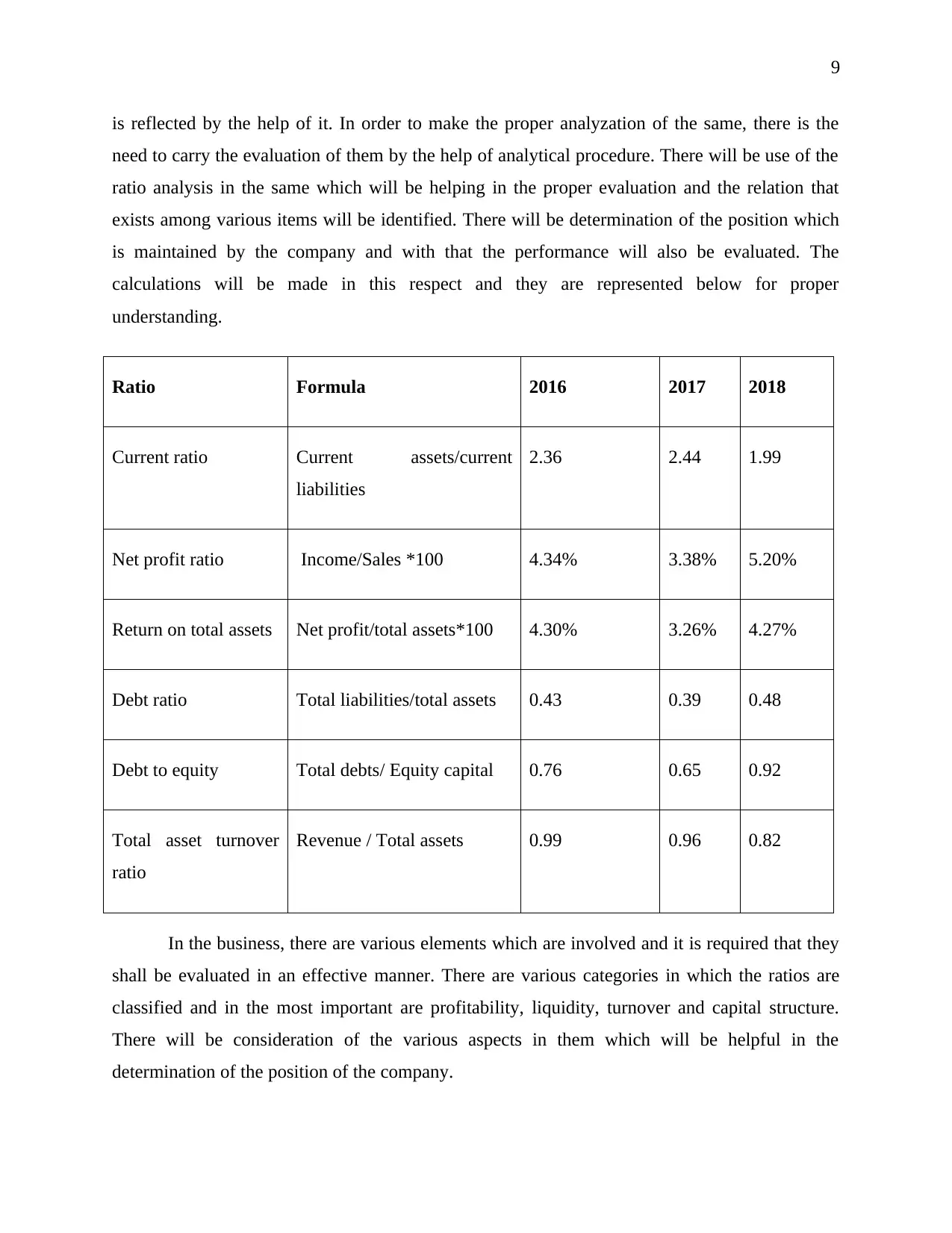
9
is reflected by the help of it. In order to make the proper analyzation of the same, there is the
need to carry the evaluation of them by the help of analytical procedure. There will be use of the
ratio analysis in the same which will be helping in the proper evaluation and the relation that
exists among various items will be identified. There will be determination of the position which
is maintained by the company and with that the performance will also be evaluated. The
calculations will be made in this respect and they are represented below for proper
understanding.
Ratio Formula 2016 2017 2018
Current ratio Current assets/current
liabilities
2.36 2.44 1.99
Net profit ratio Income/Sales *100 4.34% 3.38% 5.20%
Return on total assets Net profit/total assets*100 4.30% 3.26% 4.27%
Debt ratio Total liabilities/total assets 0.43 0.39 0.48
Debt to equity Total debts/ Equity capital 0.76 0.65 0.92
Total asset turnover
ratio
Revenue / Total assets 0.99 0.96 0.82
In the business, there are various elements which are involved and it is required that they
shall be evaluated in an effective manner. There are various categories in which the ratios are
classified and in the most important are profitability, liquidity, turnover and capital structure.
There will be consideration of the various aspects in them which will be helpful in the
determination of the position of the company.
is reflected by the help of it. In order to make the proper analyzation of the same, there is the
need to carry the evaluation of them by the help of analytical procedure. There will be use of the
ratio analysis in the same which will be helping in the proper evaluation and the relation that
exists among various items will be identified. There will be determination of the position which
is maintained by the company and with that the performance will also be evaluated. The
calculations will be made in this respect and they are represented below for proper
understanding.
Ratio Formula 2016 2017 2018
Current ratio Current assets/current
liabilities
2.36 2.44 1.99
Net profit ratio Income/Sales *100 4.34% 3.38% 5.20%
Return on total assets Net profit/total assets*100 4.30% 3.26% 4.27%
Debt ratio Total liabilities/total assets 0.43 0.39 0.48
Debt to equity Total debts/ Equity capital 0.76 0.65 0.92
Total asset turnover
ratio
Revenue / Total assets 0.99 0.96 0.82
In the business, there are various elements which are involved and it is required that they
shall be evaluated in an effective manner. There are various categories in which the ratios are
classified and in the most important are profitability, liquidity, turnover and capital structure.
There will be consideration of the various aspects in them which will be helpful in the
determination of the position of the company.
⊘ This is a preview!⊘
Do you want full access?
Subscribe today to unlock all pages.

Trusted by 1+ million students worldwide

10
The liquidity of the company has been analyzed and in that there is the consideration of
the current ratio. The ratio is calculated by the help of current assets and current liabilities. There
will be comparison which will be made and it will ensure the ability of the company to repay its
debts. In this, it is analyzed that company will be able to pay off the liabilities on time or not. For
this the calculation is made and it is identified that the same is increasing from 2.36 to 2.44 in
2017 and after that there is some decline which is faced and it declined to 1.99 (Legend
Corporation Limited, 2017). After this also the company is in good position and there is adequate
liquidity which is maintained. It can be said that company is efficient in maintaining the liquidity
and will be paying all of the liabilities on time.
The profitability position of the company has been analyzed and it is identified that there
are improvements which are made in the same. The ratio has increased and this is because of the
rise in the income which made in spite of the decline which is made in the sales. The net profit
margin is maintained and there is a good amount of the return which has been earned by the
company on the total assets which are involved. The position of the debt in the company is
maintained at adequate level. There is a debt ratio of 0.43 in 2016 and it has increased to 0.48 in
2018. This is the level at which company will be able to meet with the expenses which are
incurred in relation to the debts. There will be proper position which will be maintained and no
issue will be faced in dealing with the liabilities. The turnover of the company is required to be
maintained with the help of the available resources (Legend Corporation Limited, 2018). There
are total assets which are involved in the company and there is more investment which has been
made in the company and the assets are increasing with time. The ratio which has been identified
is decreasing and it shows that company is not maintained the proper ratio between the available
resources and sales which is made. This shows that proper utilization of the assets is not made in
the company and it is required to improve the process by which the growth can be gained in the
coming time.
Materiality
The materiality is an important concept which is specified in the auditing standard ASA
320. According to this, there are several such accounts which are material and will be in the
position to affect the other accounts and results that are obtained in the company. There are
The liquidity of the company has been analyzed and in that there is the consideration of
the current ratio. The ratio is calculated by the help of current assets and current liabilities. There
will be comparison which will be made and it will ensure the ability of the company to repay its
debts. In this, it is analyzed that company will be able to pay off the liabilities on time or not. For
this the calculation is made and it is identified that the same is increasing from 2.36 to 2.44 in
2017 and after that there is some decline which is faced and it declined to 1.99 (Legend
Corporation Limited, 2017). After this also the company is in good position and there is adequate
liquidity which is maintained. It can be said that company is efficient in maintaining the liquidity
and will be paying all of the liabilities on time.
The profitability position of the company has been analyzed and it is identified that there
are improvements which are made in the same. The ratio has increased and this is because of the
rise in the income which made in spite of the decline which is made in the sales. The net profit
margin is maintained and there is a good amount of the return which has been earned by the
company on the total assets which are involved. The position of the debt in the company is
maintained at adequate level. There is a debt ratio of 0.43 in 2016 and it has increased to 0.48 in
2018. This is the level at which company will be able to meet with the expenses which are
incurred in relation to the debts. There will be proper position which will be maintained and no
issue will be faced in dealing with the liabilities. The turnover of the company is required to be
maintained with the help of the available resources (Legend Corporation Limited, 2018). There
are total assets which are involved in the company and there is more investment which has been
made in the company and the assets are increasing with time. The ratio which has been identified
is decreasing and it shows that company is not maintained the proper ratio between the available
resources and sales which is made. This shows that proper utilization of the assets is not made in
the company and it is required to improve the process by which the growth can be gained in the
coming time.
Materiality
The materiality is an important concept which is specified in the auditing standard ASA
320. According to this, there are several such accounts which are material and will be in the
position to affect the other accounts and results that are obtained in the company. There are
Paraphrase This Document
Need a fresh take? Get an instant paraphrase of this document with our AI Paraphraser
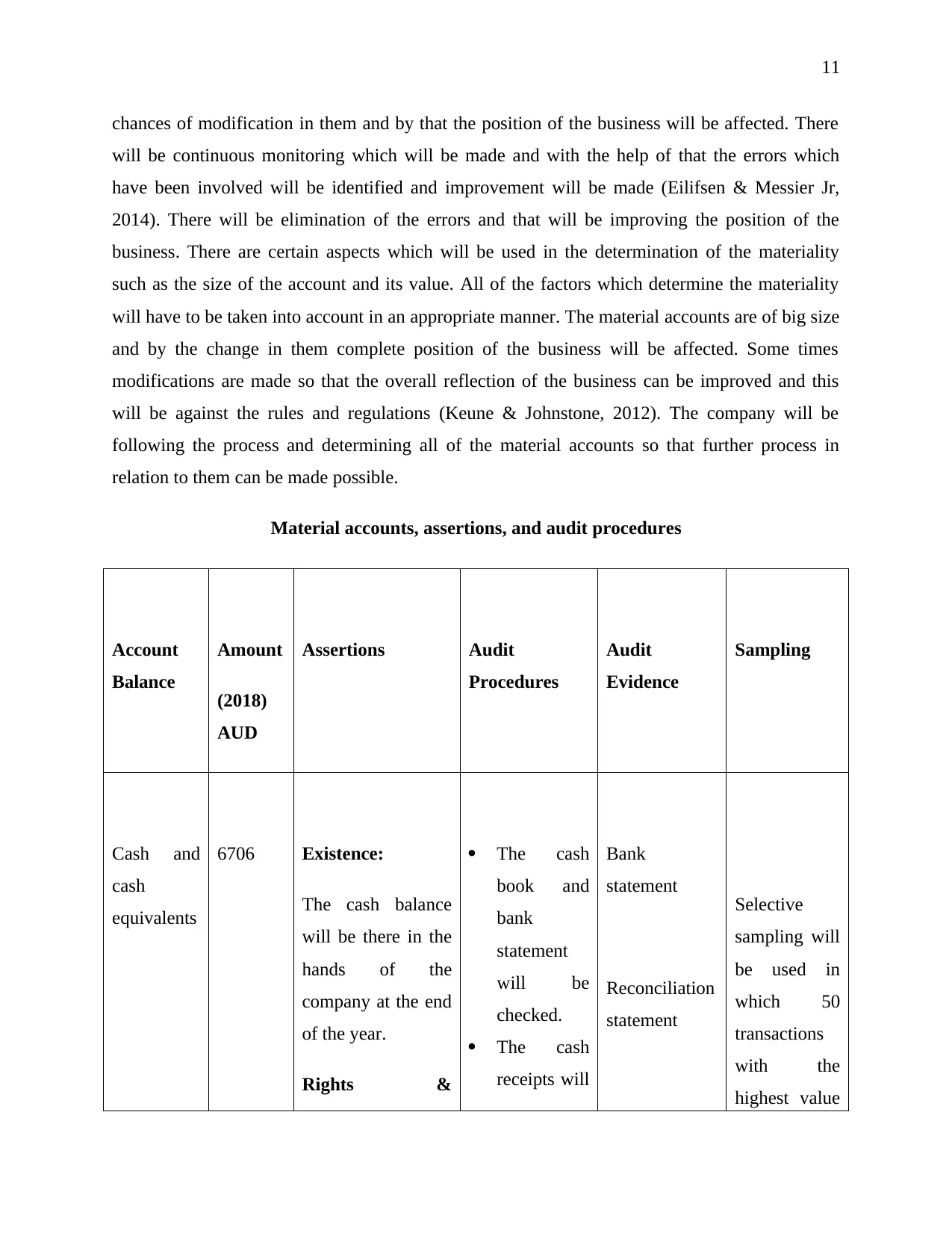
11
chances of modification in them and by that the position of the business will be affected. There
will be continuous monitoring which will be made and with the help of that the errors which
have been involved will be identified and improvement will be made (Eilifsen & Messier Jr,
2014). There will be elimination of the errors and that will be improving the position of the
business. There are certain aspects which will be used in the determination of the materiality
such as the size of the account and its value. All of the factors which determine the materiality
will have to be taken into account in an appropriate manner. The material accounts are of big size
and by the change in them complete position of the business will be affected. Some times
modifications are made so that the overall reflection of the business can be improved and this
will be against the rules and regulations (Keune & Johnstone, 2012). The company will be
following the process and determining all of the material accounts so that further process in
relation to them can be made possible.
Material accounts, assertions, and audit procedures
Account
Balance
Amount
(2018)
AUD
Assertions Audit
Procedures
Audit
Evidence
Sampling
Cash and
cash
equivalents
6706 Existence:
The cash balance
will be there in the
hands of the
company at the end
of the year.
Rights &
The cash
book and
bank
statement
will be
checked.
The cash
receipts will
Bank
statement
Reconciliation
statement
Selective
sampling will
be used in
which 50
transactions
with the
highest value
chances of modification in them and by that the position of the business will be affected. There
will be continuous monitoring which will be made and with the help of that the errors which
have been involved will be identified and improvement will be made (Eilifsen & Messier Jr,
2014). There will be elimination of the errors and that will be improving the position of the
business. There are certain aspects which will be used in the determination of the materiality
such as the size of the account and its value. All of the factors which determine the materiality
will have to be taken into account in an appropriate manner. The material accounts are of big size
and by the change in them complete position of the business will be affected. Some times
modifications are made so that the overall reflection of the business can be improved and this
will be against the rules and regulations (Keune & Johnstone, 2012). The company will be
following the process and determining all of the material accounts so that further process in
relation to them can be made possible.
Material accounts, assertions, and audit procedures
Account
Balance
Amount
(2018)
AUD
Assertions Audit
Procedures
Audit
Evidence
Sampling
Cash and
cash
equivalents
6706 Existence:
The cash balance
will be there in the
hands of the
company at the end
of the year.
Rights &
The cash
book and
bank
statement
will be
checked.
The cash
receipts will
Bank
statement
Reconciliation
statement
Selective
sampling will
be used in
which 50
transactions
with the
highest value
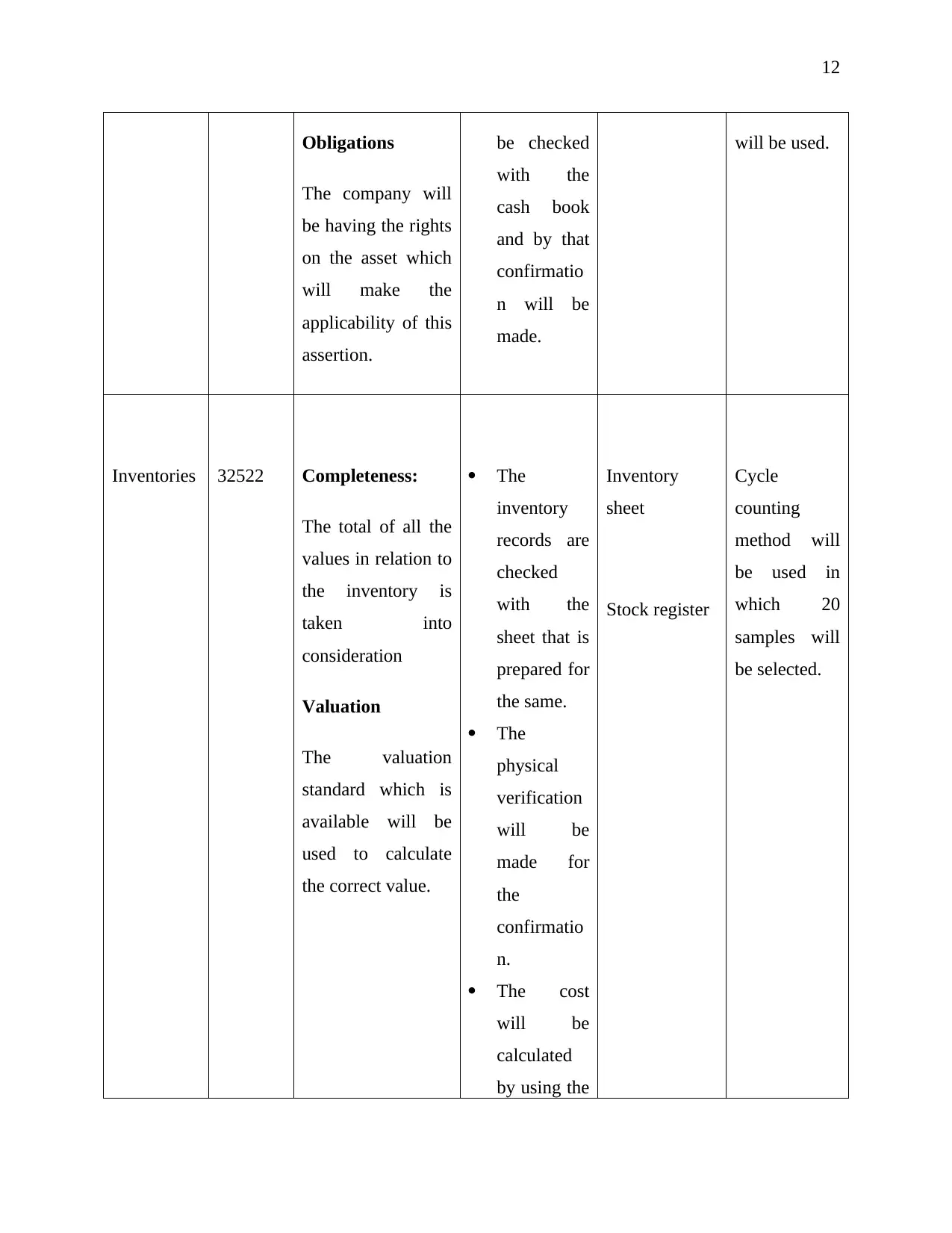
12
Obligations
The company will
be having the rights
on the asset which
will make the
applicability of this
assertion.
be checked
with the
cash book
and by that
confirmatio
n will be
made.
will be used.
Inventories 32522 Completeness:
The total of all the
values in relation to
the inventory is
taken into
consideration
Valuation
The valuation
standard which is
available will be
used to calculate
the correct value.
The
inventory
records are
checked
with the
sheet that is
prepared for
the same.
The
physical
verification
will be
made for
the
confirmatio
n.
The cost
will be
calculated
by using the
Inventory
sheet
Stock register
Cycle
counting
method will
be used in
which 20
samples will
be selected.
Obligations
The company will
be having the rights
on the asset which
will make the
applicability of this
assertion.
be checked
with the
cash book
and by that
confirmatio
n will be
made.
will be used.
Inventories 32522 Completeness:
The total of all the
values in relation to
the inventory is
taken into
consideration
Valuation
The valuation
standard which is
available will be
used to calculate
the correct value.
The
inventory
records are
checked
with the
sheet that is
prepared for
the same.
The
physical
verification
will be
made for
the
confirmatio
n.
The cost
will be
calculated
by using the
Inventory
sheet
Stock register
Cycle
counting
method will
be used in
which 20
samples will
be selected.
⊘ This is a preview!⊘
Do you want full access?
Subscribe today to unlock all pages.

Trusted by 1+ million students worldwide
1 out of 21
Related Documents
Your All-in-One AI-Powered Toolkit for Academic Success.
+13062052269
info@desklib.com
Available 24*7 on WhatsApp / Email
![[object Object]](/_next/static/media/star-bottom.7253800d.svg)
Unlock your academic potential
Copyright © 2020–2025 A2Z Services. All Rights Reserved. Developed and managed by ZUCOL.




